Social Identity Theory and its Relevance in Today's World
VerifiedAdded on 2023/05/29
|6
|1323
|479
AI Summary
This essay provides a critical analysis of the theoretical construct of social identity theory and its relevance in today’s world. It explains the process of self comparison and the assertion of the superiority of the self. The relevance of the social identity theory has not faded away in the contemporary period.
Contribute Materials
Your contribution can guide someone’s learning journey. Share your
documents today.
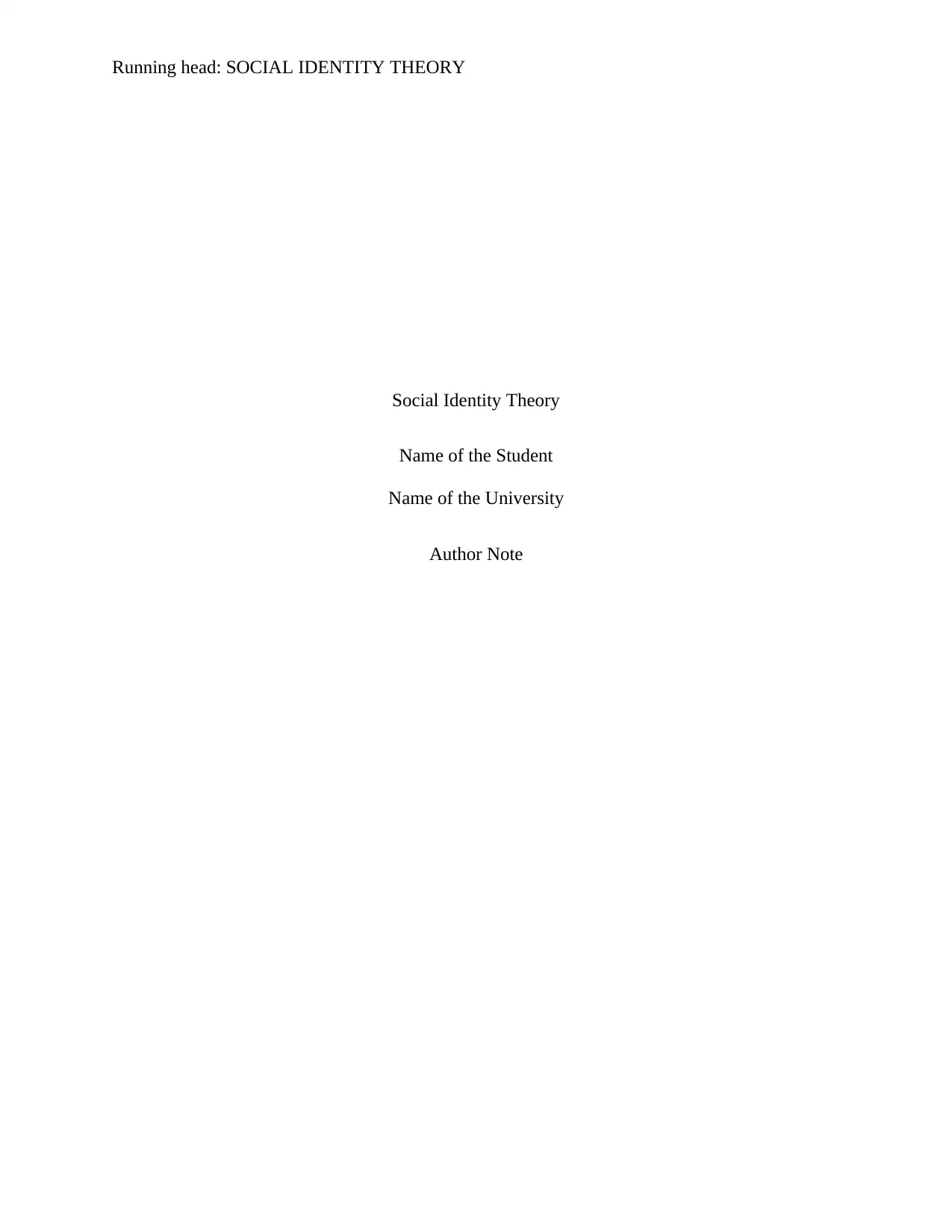
Running head: SOCIAL IDENTITY THEORY
Social Identity Theory
Name of the Student
Name of the University
Author Note
Social Identity Theory
Name of the Student
Name of the University
Author Note
Secure Best Marks with AI Grader
Need help grading? Try our AI Grader for instant feedback on your assignments.
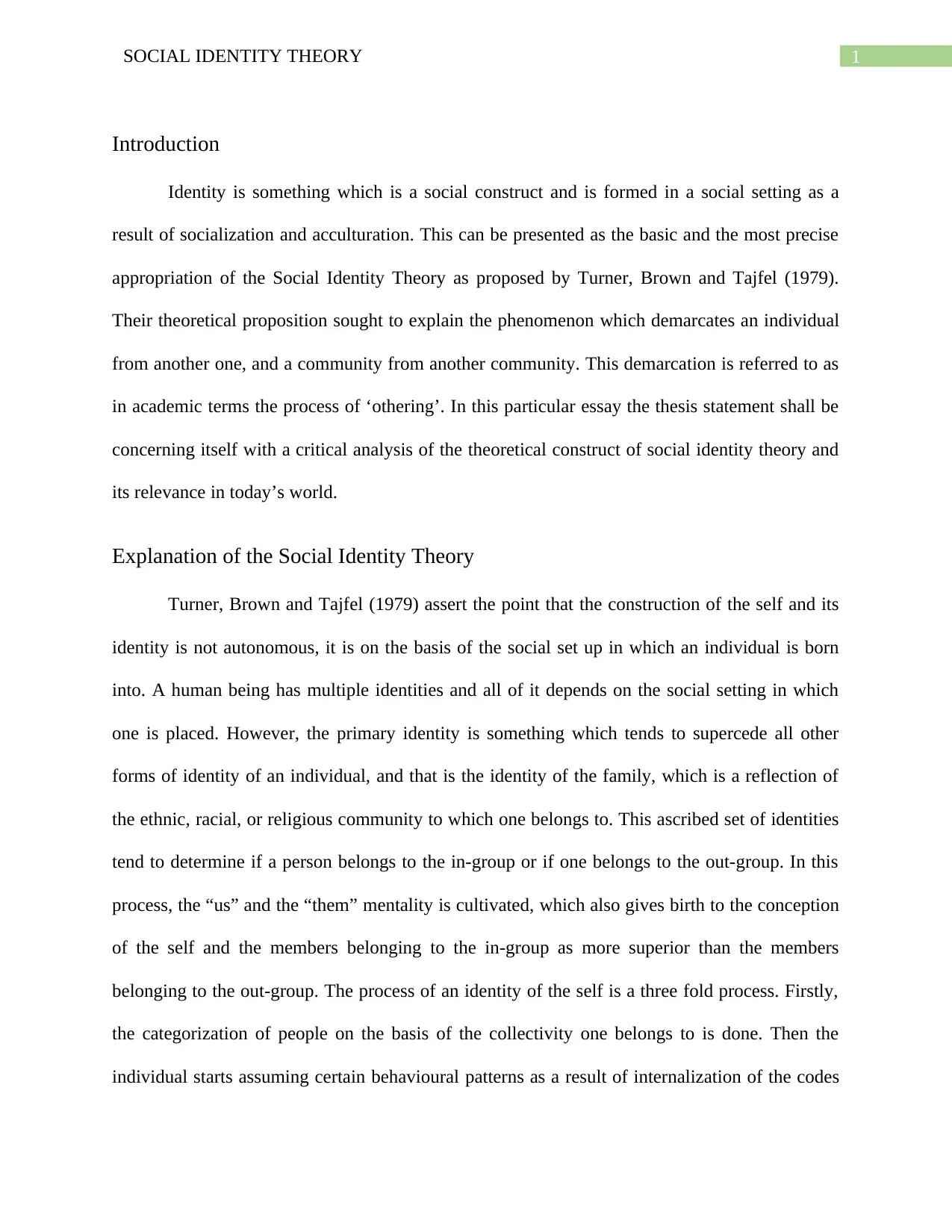
1SOCIAL IDENTITY THEORY
Introduction
Identity is something which is a social construct and is formed in a social setting as a
result of socialization and acculturation. This can be presented as the basic and the most precise
appropriation of the Social Identity Theory as proposed by Turner, Brown and Tajfel (1979).
Their theoretical proposition sought to explain the phenomenon which demarcates an individual
from another one, and a community from another community. This demarcation is referred to as
in academic terms the process of ‘othering’. In this particular essay the thesis statement shall be
concerning itself with a critical analysis of the theoretical construct of social identity theory and
its relevance in today’s world.
Explanation of the Social Identity Theory
Turner, Brown and Tajfel (1979) assert the point that the construction of the self and its
identity is not autonomous, it is on the basis of the social set up in which an individual is born
into. A human being has multiple identities and all of it depends on the social setting in which
one is placed. However, the primary identity is something which tends to supercede all other
forms of identity of an individual, and that is the identity of the family, which is a reflection of
the ethnic, racial, or religious community to which one belongs to. This ascribed set of identities
tend to determine if a person belongs to the in-group or if one belongs to the out-group. In this
process, the “us” and the “them” mentality is cultivated, which also gives birth to the conception
of the self and the members belonging to the in-group as more superior than the members
belonging to the out-group. The process of an identity of the self is a three fold process. Firstly,
the categorization of people on the basis of the collectivity one belongs to is done. Then the
individual starts assuming certain behavioural patterns as a result of internalization of the codes
Introduction
Identity is something which is a social construct and is formed in a social setting as a
result of socialization and acculturation. This can be presented as the basic and the most precise
appropriation of the Social Identity Theory as proposed by Turner, Brown and Tajfel (1979).
Their theoretical proposition sought to explain the phenomenon which demarcates an individual
from another one, and a community from another community. This demarcation is referred to as
in academic terms the process of ‘othering’. In this particular essay the thesis statement shall be
concerning itself with a critical analysis of the theoretical construct of social identity theory and
its relevance in today’s world.
Explanation of the Social Identity Theory
Turner, Brown and Tajfel (1979) assert the point that the construction of the self and its
identity is not autonomous, it is on the basis of the social set up in which an individual is born
into. A human being has multiple identities and all of it depends on the social setting in which
one is placed. However, the primary identity is something which tends to supercede all other
forms of identity of an individual, and that is the identity of the family, which is a reflection of
the ethnic, racial, or religious community to which one belongs to. This ascribed set of identities
tend to determine if a person belongs to the in-group or if one belongs to the out-group. In this
process, the “us” and the “them” mentality is cultivated, which also gives birth to the conception
of the self and the members belonging to the in-group as more superior than the members
belonging to the out-group. The process of an identity of the self is a three fold process. Firstly,
the categorization of people on the basis of the collectivity one belongs to is done. Then the
individual starts assuming certain behavioural patterns as a result of internalization of the codes
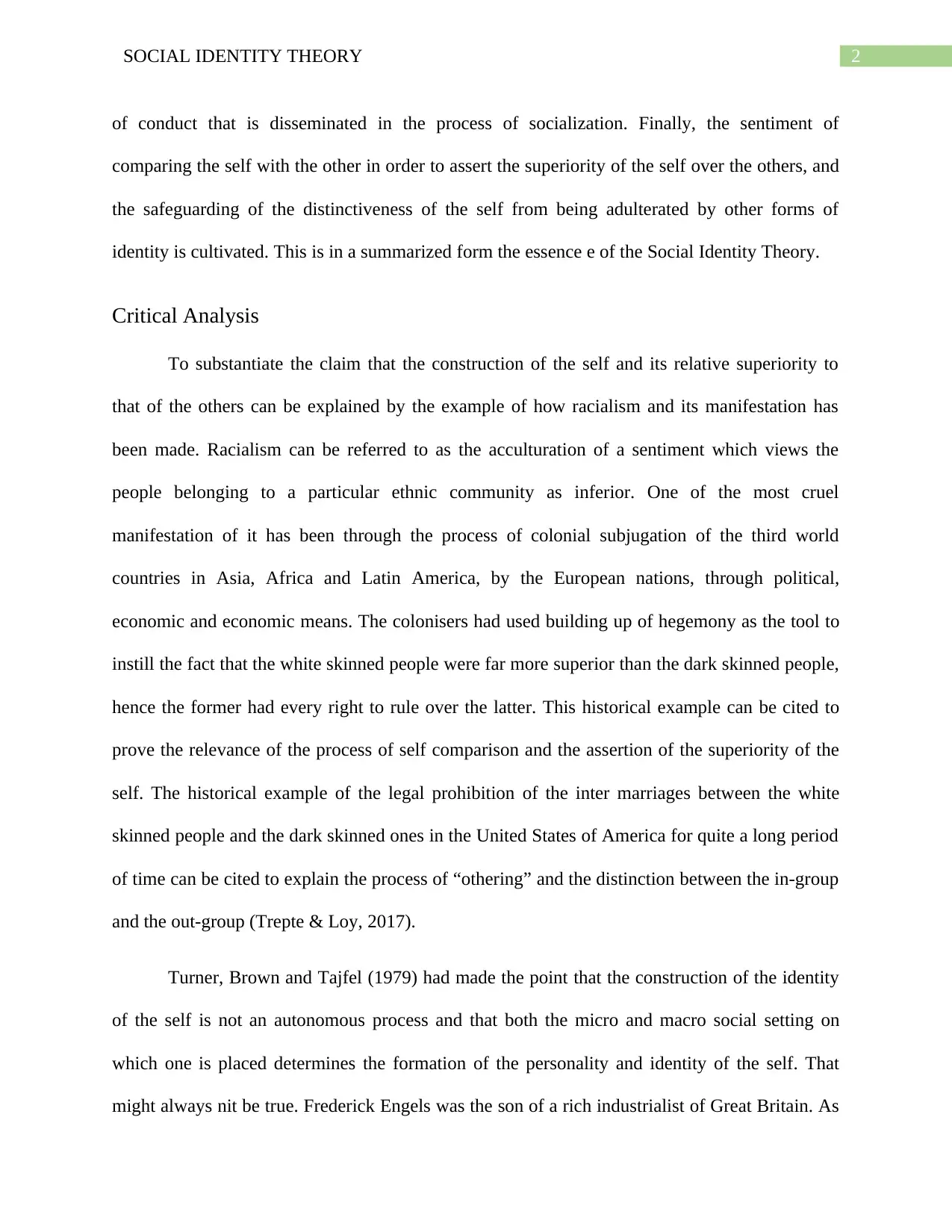
2SOCIAL IDENTITY THEORY
of conduct that is disseminated in the process of socialization. Finally, the sentiment of
comparing the self with the other in order to assert the superiority of the self over the others, and
the safeguarding of the distinctiveness of the self from being adulterated by other forms of
identity is cultivated. This is in a summarized form the essence e of the Social Identity Theory.
Critical Analysis
To substantiate the claim that the construction of the self and its relative superiority to
that of the others can be explained by the example of how racialism and its manifestation has
been made. Racialism can be referred to as the acculturation of a sentiment which views the
people belonging to a particular ethnic community as inferior. One of the most cruel
manifestation of it has been through the process of colonial subjugation of the third world
countries in Asia, Africa and Latin America, by the European nations, through political,
economic and economic means. The colonisers had used building up of hegemony as the tool to
instill the fact that the white skinned people were far more superior than the dark skinned people,
hence the former had every right to rule over the latter. This historical example can be cited to
prove the relevance of the process of self comparison and the assertion of the superiority of the
self. The historical example of the legal prohibition of the inter marriages between the white
skinned people and the dark skinned ones in the United States of America for quite a long period
of time can be cited to explain the process of “othering” and the distinction between the in-group
and the out-group (Trepte & Loy, 2017).
Turner, Brown and Tajfel (1979) had made the point that the construction of the identity
of the self is not an autonomous process and that both the micro and macro social setting on
which one is placed determines the formation of the personality and identity of the self. That
might always nit be true. Frederick Engels was the son of a rich industrialist of Great Britain. As
of conduct that is disseminated in the process of socialization. Finally, the sentiment of
comparing the self with the other in order to assert the superiority of the self over the others, and
the safeguarding of the distinctiveness of the self from being adulterated by other forms of
identity is cultivated. This is in a summarized form the essence e of the Social Identity Theory.
Critical Analysis
To substantiate the claim that the construction of the self and its relative superiority to
that of the others can be explained by the example of how racialism and its manifestation has
been made. Racialism can be referred to as the acculturation of a sentiment which views the
people belonging to a particular ethnic community as inferior. One of the most cruel
manifestation of it has been through the process of colonial subjugation of the third world
countries in Asia, Africa and Latin America, by the European nations, through political,
economic and economic means. The colonisers had used building up of hegemony as the tool to
instill the fact that the white skinned people were far more superior than the dark skinned people,
hence the former had every right to rule over the latter. This historical example can be cited to
prove the relevance of the process of self comparison and the assertion of the superiority of the
self. The historical example of the legal prohibition of the inter marriages between the white
skinned people and the dark skinned ones in the United States of America for quite a long period
of time can be cited to explain the process of “othering” and the distinction between the in-group
and the out-group (Trepte & Loy, 2017).
Turner, Brown and Tajfel (1979) had made the point that the construction of the identity
of the self is not an autonomous process and that both the micro and macro social setting on
which one is placed determines the formation of the personality and identity of the self. That
might always nit be true. Frederick Engels was the son of a rich industrialist of Great Britain. As
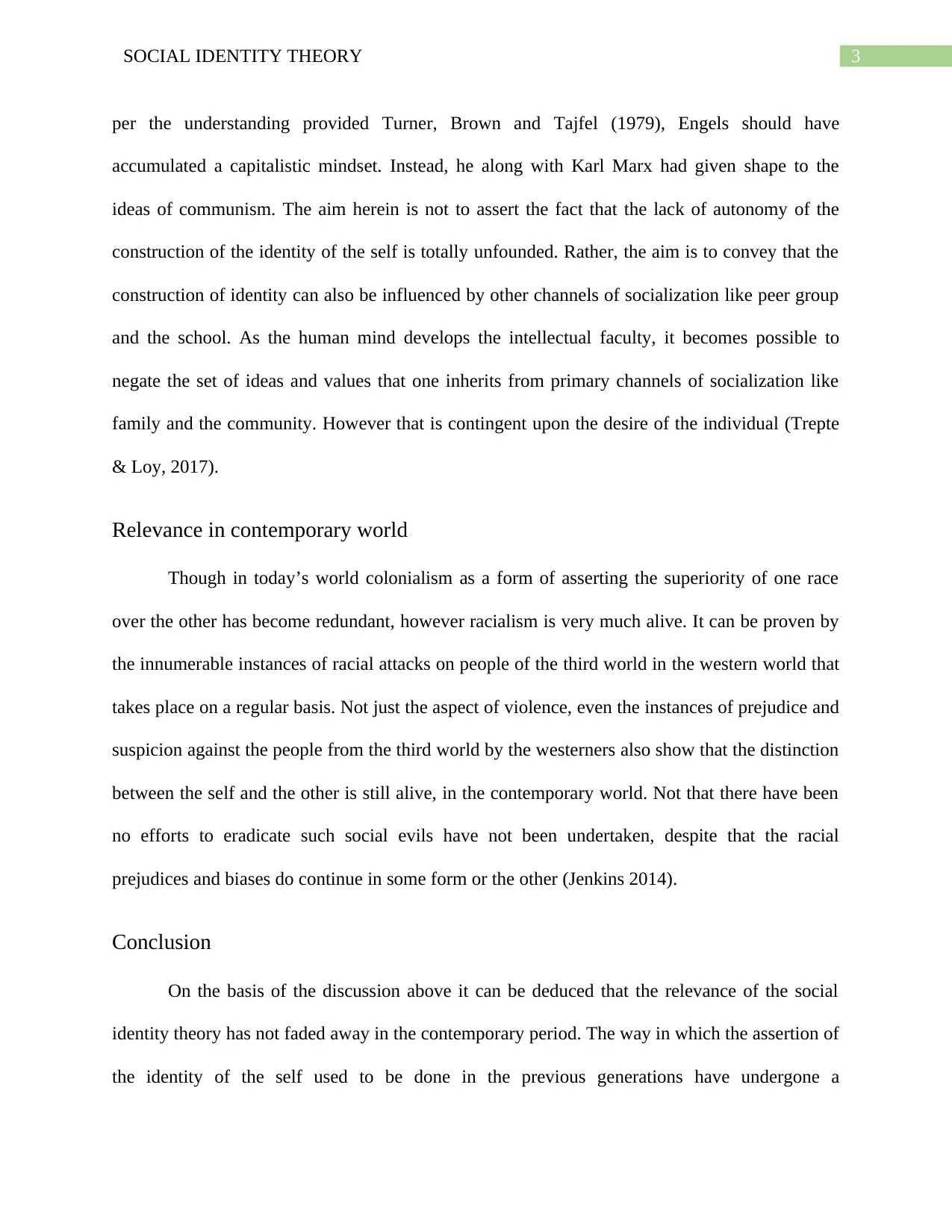
3SOCIAL IDENTITY THEORY
per the understanding provided Turner, Brown and Tajfel (1979), Engels should have
accumulated a capitalistic mindset. Instead, he along with Karl Marx had given shape to the
ideas of communism. The aim herein is not to assert the fact that the lack of autonomy of the
construction of the identity of the self is totally unfounded. Rather, the aim is to convey that the
construction of identity can also be influenced by other channels of socialization like peer group
and the school. As the human mind develops the intellectual faculty, it becomes possible to
negate the set of ideas and values that one inherits from primary channels of socialization like
family and the community. However that is contingent upon the desire of the individual (Trepte
& Loy, 2017).
Relevance in contemporary world
Though in today’s world colonialism as a form of asserting the superiority of one race
over the other has become redundant, however racialism is very much alive. It can be proven by
the innumerable instances of racial attacks on people of the third world in the western world that
takes place on a regular basis. Not just the aspect of violence, even the instances of prejudice and
suspicion against the people from the third world by the westerners also show that the distinction
between the self and the other is still alive, in the contemporary world. Not that there have been
no efforts to eradicate such social evils have not been undertaken, despite that the racial
prejudices and biases do continue in some form or the other (Jenkins 2014).
Conclusion
On the basis of the discussion above it can be deduced that the relevance of the social
identity theory has not faded away in the contemporary period. The way in which the assertion of
the identity of the self used to be done in the previous generations have undergone a
per the understanding provided Turner, Brown and Tajfel (1979), Engels should have
accumulated a capitalistic mindset. Instead, he along with Karl Marx had given shape to the
ideas of communism. The aim herein is not to assert the fact that the lack of autonomy of the
construction of the identity of the self is totally unfounded. Rather, the aim is to convey that the
construction of identity can also be influenced by other channels of socialization like peer group
and the school. As the human mind develops the intellectual faculty, it becomes possible to
negate the set of ideas and values that one inherits from primary channels of socialization like
family and the community. However that is contingent upon the desire of the individual (Trepte
& Loy, 2017).
Relevance in contemporary world
Though in today’s world colonialism as a form of asserting the superiority of one race
over the other has become redundant, however racialism is very much alive. It can be proven by
the innumerable instances of racial attacks on people of the third world in the western world that
takes place on a regular basis. Not just the aspect of violence, even the instances of prejudice and
suspicion against the people from the third world by the westerners also show that the distinction
between the self and the other is still alive, in the contemporary world. Not that there have been
no efforts to eradicate such social evils have not been undertaken, despite that the racial
prejudices and biases do continue in some form or the other (Jenkins 2014).
Conclusion
On the basis of the discussion above it can be deduced that the relevance of the social
identity theory has not faded away in the contemporary period. The way in which the assertion of
the identity of the self used to be done in the previous generations have undergone a
Secure Best Marks with AI Grader
Need help grading? Try our AI Grader for instant feedback on your assignments.

4SOCIAL IDENTITY THEORY
paradigmatic shift in the contemporary times. That can be attribute to the development of new
ideas and the opening up of human mind to a whole new world of ideas.
paradigmatic shift in the contemporary times. That can be attribute to the development of new
ideas and the opening up of human mind to a whole new world of ideas.
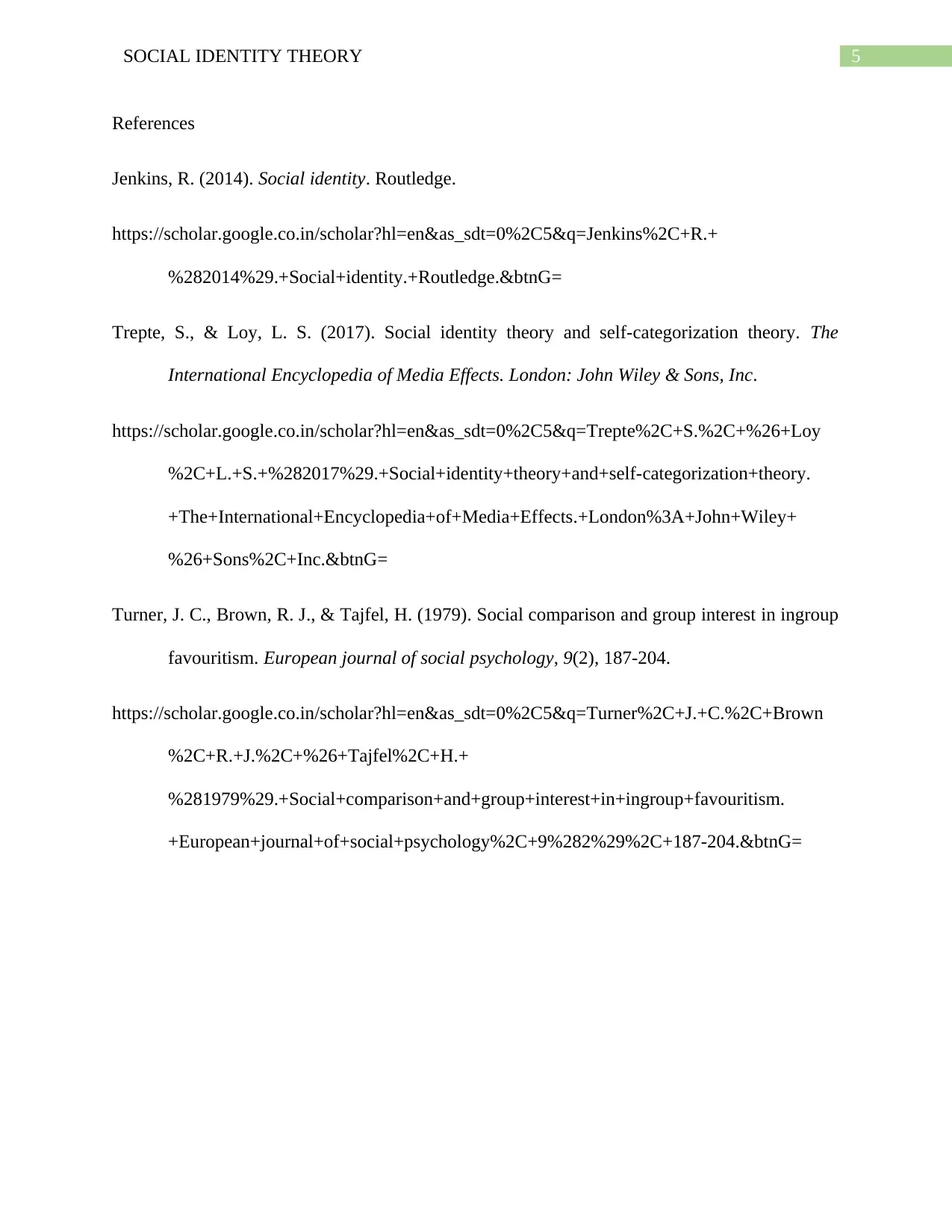
5SOCIAL IDENTITY THEORY
References
Jenkins, R. (2014). Social identity. Routledge.
https://scholar.google.co.in/scholar?hl=en&as_sdt=0%2C5&q=Jenkins%2C+R.+
%282014%29.+Social+identity.+Routledge.&btnG=
Trepte, S., & Loy, L. S. (2017). Social identity theory and self-categorization theory. The
International Encyclopedia of Media Effects. London: John Wiley & Sons, Inc.
https://scholar.google.co.in/scholar?hl=en&as_sdt=0%2C5&q=Trepte%2C+S.%2C+%26+Loy
%2C+L.+S.+%282017%29.+Social+identity+theory+and+self-categorization+theory.
+The+International+Encyclopedia+of+Media+Effects.+London%3A+John+Wiley+
%26+Sons%2C+Inc.&btnG=
Turner, J. C., Brown, R. J., & Tajfel, H. (1979). Social comparison and group interest in ingroup
favouritism. European journal of social psychology, 9(2), 187-204.
https://scholar.google.co.in/scholar?hl=en&as_sdt=0%2C5&q=Turner%2C+J.+C.%2C+Brown
%2C+R.+J.%2C+%26+Tajfel%2C+H.+
%281979%29.+Social+comparison+and+group+interest+in+ingroup+favouritism.
+European+journal+of+social+psychology%2C+9%282%29%2C+187-204.&btnG=
References
Jenkins, R. (2014). Social identity. Routledge.
https://scholar.google.co.in/scholar?hl=en&as_sdt=0%2C5&q=Jenkins%2C+R.+
%282014%29.+Social+identity.+Routledge.&btnG=
Trepte, S., & Loy, L. S. (2017). Social identity theory and self-categorization theory. The
International Encyclopedia of Media Effects. London: John Wiley & Sons, Inc.
https://scholar.google.co.in/scholar?hl=en&as_sdt=0%2C5&q=Trepte%2C+S.%2C+%26+Loy
%2C+L.+S.+%282017%29.+Social+identity+theory+and+self-categorization+theory.
+The+International+Encyclopedia+of+Media+Effects.+London%3A+John+Wiley+
%26+Sons%2C+Inc.&btnG=
Turner, J. C., Brown, R. J., & Tajfel, H. (1979). Social comparison and group interest in ingroup
favouritism. European journal of social psychology, 9(2), 187-204.
https://scholar.google.co.in/scholar?hl=en&as_sdt=0%2C5&q=Turner%2C+J.+C.%2C+Brown
%2C+R.+J.%2C+%26+Tajfel%2C+H.+
%281979%29.+Social+comparison+and+group+interest+in+ingroup+favouritism.
+European+journal+of+social+psychology%2C+9%282%29%2C+187-204.&btnG=
1 out of 6
Related Documents
Your All-in-One AI-Powered Toolkit for Academic Success.
+13062052269
info@desklib.com
Available 24*7 on WhatsApp / Email
![[object Object]](/_next/static/media/star-bottom.7253800d.svg)
Unlock your academic potential
© 2024 | Zucol Services PVT LTD | All rights reserved.





